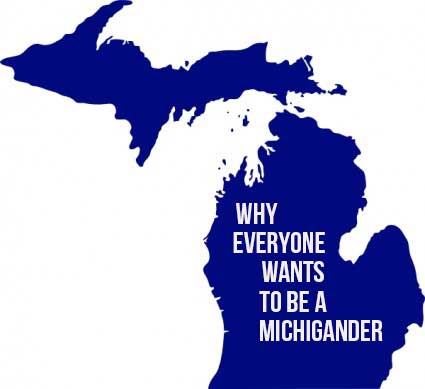Why Everyone Wants to be a Michigander
 Last week we looked at our state flag with its “super bad” elk, moose and tough guy packing a long gun, and how it demonstrates our fierce love for our pleasant peninsulas. This week we’ll look at how this place we call Michigan became the 26th state in the Union. Did you know we almost went to war with Ohio?
Last week we looked at our state flag with its “super bad” elk, moose and tough guy packing a long gun, and how it demonstrates our fierce love for our pleasant peninsulas. This week we’ll look at how this place we call Michigan became the 26th state in the Union. Did you know we almost went to war with Ohio?
The French were the first Europeans to settle Michigan. The came down from Canada in the early 1600s to explore the Great Lakes and trade with the Native Americans. The French controlled the area for a long time, establishing a fort in what is present day Detroit in 1701. Just imagine, if the French had stuck around, we might be eating escargot instead of Coney dogs.
But the British got wind of the vast resources and sugar sand beaches in the Great Lakes region and wanted a piece of the action too. The British fought the French and eventually won what we refer to as The French and Indian War. In 1763 Britain gained control of Canada and a large portion of what is the Northeastern United States today, including Michigan.
Britain didn’t get its chance to build summer houses along Lake Michigan though, because George Washington and a group of rough and tumble Patriots out east were about to get upset about having their tea over-taxed. Of course, we all know that resulted in the Revolutionary War. The colonists established the United States of America and sent the Redcoats packing. We let them keep Canada and hockey, but made them give us everything east of the Mississippi, including Michigan.
Immediately following the Revolutionary War, Michigan was part of the Northwest Territory, which was pretty much everything north and west of the Ohio river. Then that was broken up in 1800, and Michigan became part of the Indiana Territory. We weren’t Hoosiers for very long. When Indiana became a state in 1816, we were split into our own territory, and officially named Michigan for the first time.
Today, there’s still confusion over where the border lies between Michigan and Indiana. Originally Michigan was to include everything from the southern tip of Lake Michigan to Lake Erie. But just like Britain and France before them, Indiana wanted a piece of the Great Lakes. The Hoosier state convinced President James Madison to move the border 10 miles north, so Indiana could have its own port for shipping.
However the border was marked by wooden stakes in 1827. Those markers have since disappeared. According to notes from the original survey, state boundaries today may actually overlap. Some Michiganders might soon be calling themselves Hoosiers again. The state legislatures have been trying to sort it out for years.
Things got really sticky when Michigan applied for statehood in 1835. Michigan and Ohio both wanted the area around Toledo, because of its proximity to Lake Erie and the Maumee River. Thanks to another land survey mistake, both states thought the land belonged to them. Neither state would cede to the other. The governors went so far as to send militias to face-off against each other on opposite sides of the river. Though it’s called The Toledo War, the battle resulted in nothing more than a few shots fired into the air.
Congress settled the dispute by giving the Toledo strip to Ohio and giving Michigan the Upper Peninsula as a peace-offering. We actually ended up with the better end of the deal. But neither state ever quite got over the land-grab. Today we hash out our differences on football fields when the University of Michigan plays against Ohio State.
Finally in 1837, Michigan officially entered the Union. Our Great Lakes, modern cities, vast wilderness, industrial centers and rich agricultural lands make us one of the most diverse states when it comes to resources. No wonder Michigan and Indiana wanted in on it. It’s a special place, and Michiganders are proud to call it home.



